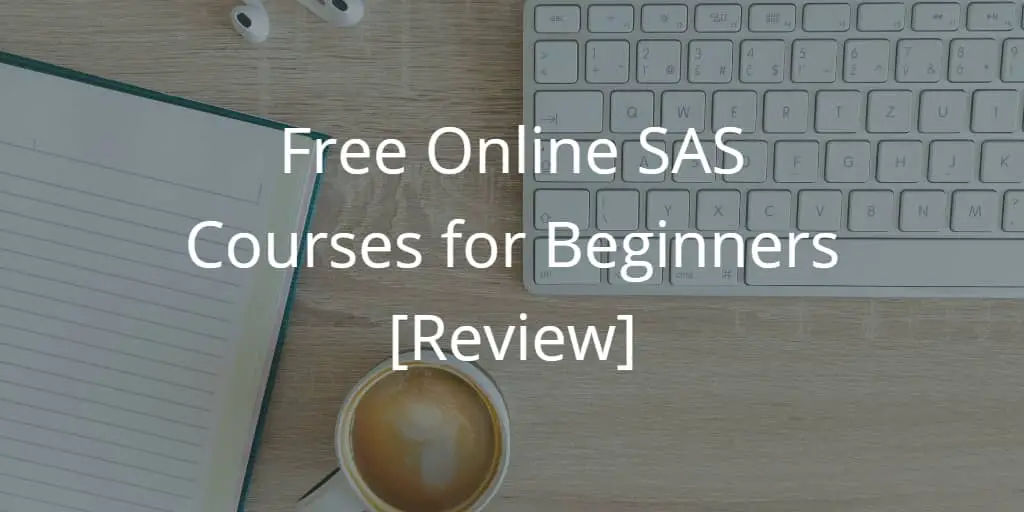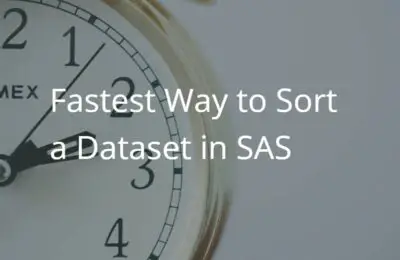So, you want to get started with SAS. That is a good choice because SAS programmers are in high demand. But, where do you start?
There are many ways to get started with SAS: internet, books, classroom courses, online courses, etc. In this article, I review and compare two 2 Free Official Online SAS Courses for Beginners that you can follow at your own pace.
I will review the course content, the course material, the certification, etc.
The two courses that I will discuss and compare are:
- SAS Programming 1: Essentials (from sas.com)
- Getting Started with SAS Programming (offered by SAS on Coursera)
If you want to read directly my recommendations, then scroll down to the section with Conclusions.
Contents
Introduction
The SAS Programming 1: Essentials course is a free online course offered on the official SAS website. It is the entry point for anyone who wants to start with SAS. You learn how to write SAS programs to access, explore, prepare, and analyze data.
The Getting Started with SAS Programming course is another free* online SAS course for beginners. This course is offered by SAS on the Coursera platform.
*Important: To follow this course for free, you need to enroll yourself as someone who audits the course material.
Course Content
The course content of both courses is identical and consists of 8 modules (lessons). Each module takes between 1 and 5 hours to complete. This includes time for watching the videos and carrying out the exercises.
Course Outline:
- Course Overview and Data Setup (approx. 1 hour): In this module, you learn about the course outline and how to set up the SAS software.
- Essentials (approx. 2 hours): In this module, you get used to the SAS interface and the SAS editor, and learn the basics about the SAS syntax.
- Accessing Data (approx. 3 hours): In this module, you learn to identify the features of a SAS table, access data through SAS libraries, and import data into SAS.
- Exploring and Validating Data (approx. 5 hours): In this module, you learn to use SAS procedures that provide insights about your data. You also learn to subset data so you can focus on particular segments, format data so you can easily understand it, and sort data to identify and resolve duplicate values.
- Preparing Data (approx. 5 hours): In this module, you learn how to do some common data manipulations, such as filtering rows and columns, computing new columns, and performing conditional processing.
- Analyzing and Reporting on Data (approx. 4 hours): In this module, we concentrate on summarizing data by using the SAS procedures that we touched on for data exploration. You also learn how to use titles, column labels, footnotes, and macro variables to enhance your reports and make them more meaningful.
- Exporting Results (approx. 2 hours): In this module, you learn to export SAS tables and results to Excel, Microsoft Word, and PDF files.
- Using SQL in SAS (approx. 2 hours): In this module, you learn to use the SQL procedure to read and filter data. You also learn to create and join tables by using SQL.
Course Content – Quality
In my opinion, the content of the course is excellent because:
- It covers the most important topics to help you start your career as a SAS programmer.
- It is very well structured. If you follow the modules in the indicated order, you will never have the feeling that you lack knowledge when you start a new module.
- The level of detail is perfect. Each module covers the right amount of information for a SAS beginner.
Course Material
The course material consists of videos, exercises, and readings.
Course Material – Video
As for the course content, the videos of both courses are identical too (for 99.9%). The videos are of high quality and can be disthinguished into 3 types:
- Introduction. A short video that introduces a topic, presented by the course instructor.
- Theory. A video that covers the theory of a topic, presented on slides and narrated by the course instructor.
- Demo. A video where the course instructor shows her screen and writes SAS code.
A video typically takes between 3 and 4 minutes.
An advantage of the Getting Started with SAS Programming course is that you can download the videos to watch them offline. Also, this course offers subtitles in 11 languages.
Both courses offer the possibility to add notes to the videos. But, in my opinion, adding notes in the SAS Programming 1: Essentials course is more intuitive.
Course Material – Exercises
The courses also provide material to practice your SAS skills. There are 4 types of exercises.
Questions
These are multiple-choice questions that show up during or at the end of a video to test your knowledge (only for the Getting Started with SAS Programming course). The questions are optional and fairly easy to answer. Normally, no coding is needed to answer them.
Activities
Activities are small programming exercises that cover the topic of the previous video(s). If you follow the Getting Started with SAS Programming course, you have to submit your answer before you check the right solution. However, in the SAS Programming 1: Essentials course, there is a button “Show Answer” you can click without submitting an answer. For this reason, I like Getting Started with SAS Programming more. It forces you to really do the exercises.
Programming Exercises:
Programming exercises are exercises that cover the content of multiple videos. To finish these exercises it’s absolutely necessary to program in SAS.
The Getting Started with SAS Programming course offers 2 levels of exercises, namely:
- Level 1: Basic problems with step-by-step guidance
- Level 2: Intermediate problems with less guidance
In addition to these 2 levels, the SAS Programming 1: Essentials course has a third level of exercises. These so-called “Challenges” are complex problems without guidance. To solve these exercises, you might need to refer to the SAS documentation because the videos don’t always cover the solution.
Final Quiz:
At the end of each module, both courses contain a quiz of 10 questions. A big drawback of the Getting Started with SAS Programming course is that you need to upgrade your audit subscription to a paid subscription to see the answers. If you follow the SAS Programming 1: Essentials course, you can submit and see the correct solution.
So, taking all kinds of exercises into account, I think that the SAS Programming 1: Essentials course offers a better hands-on experience. Mainly because it provides an extra level of Programming Exercises (the “Challenges”) and you can see the answers to the Final Quizzes for free.
Course Material – Readings
Both courses offer readings. Normally, this is a PDF-like document with a summary of the module. This document can be very useful if you follow the course as preparation for a certification exam.
Shareable Certificate of Completion
SAS Programming 1: Essentials
Once you have completed this course, you obtain a free Digital Badge via Credly’s Acclaim platform. You can use this platform to share your achievement with your online network.

Moreover, together with the SAS Programming 2: Data Manipulation Techniques course, the SAS Programming 1: Essentials course is part of the recommended training for 2 certifications, namely:
- SAS Certified Specialist: Base Programming Using SAS 9.4
- SAS Certified Associate: Programming Fundamentals Using SAS 9.4
Getting Started with SAS Programming
If you complete this course as someone who audits the course material, you don’t earn a certificate. Only the learners who paid for the course (e.g., via Coursera Plus) get a shareable certificate of completion.
Furthermore, the Getting Started with SAS Programming course is the first of three courses in the SAS Programmer Professional Certificate program. After completing this program, you are prepared to take the SAS Certified Specialist: Base Programming Using SAS 9.4 exam.
Other Remarks
Installation of SAS Software
In the first module of both courses, you learn how to install the SAS software to do the practices and activities. You can choose from two free offerings:
- SAS OnDemand for Academics (for online use)
- SAS University Edition (for offline use)
Both courses explain how to install these offerings. However, in my opinion, the Getting Started with SAS Programming course does a better job of demonstrating how to do this. They offer clearer step-by-step guidance and videos as support.
Discussion Forum
The Getting Started with SAS Programming course provides a nice discussion forum to discuss the course content and ask questions. In general, fellow students or the course instructor answer your questions promptly. The SAS Programming 1: Essentials course doesn’t provide a way to interact with other students and/or instructors.
Conclusion
So to recommend the Best Free Online SAS Course for Beginners, my advice depends mainly on the question “Do you plan to take an official certification exam?”. It only depends on this question because the course content is identical in both courses.
If you don’t plan to take an official certification exam, I recommend you to take the SAS Programming 1: Essentials course on SAS.com. This course provides more Programming Exercises (the “Challenges”). Also, the answer to the Final Quizzes can be checked for free. Moreover, once you have completed the course, you earn a Digital Badge that you can share online.
However, if you do plan to take an official certification exam, I recommend the Getting Started with SAS Programming course on Coursera. To be prepared for the SAS Certified Specialist: Base Programming Using SAS 9.4 exam, you need to:
- Follow also the SAS Programming 2: Data Manipulation Techniques course on SAS.com (currently $780), or
- Complete the SAS Programmer Professional Certificate on Coursera
As mentioned before, the Getting Started with SAS Programming course is part of the SAS Programmer Professional Certificate program, which can be followed for free. After completing this program, you are completely prepared to take the official certification exam.
A small drawback of the Getting Started with SAS Programming course is that you don’t get a certificate of completion if you follow the course as an auditor. However, with Coursera Plus you do earn this certificate. Also, for this yearly premium, you can follow more than 3000 other courses.
If you are looking for one course that prepares you for the SAS Certified Specialist: Base Programming Using SAS 9.4 exam, I highly recommend the SAS Programming BASE certification course for SAS Beginners on Coursera (review).

